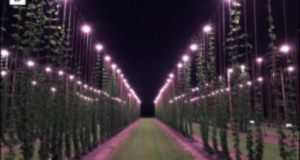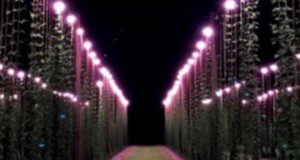The booming craft beer industry, rising prices of hops, and demand for locally-produced ingredients have recently increased interest in local hop production among growers and brewers. This article describes crop management practices and labor inputs required for small-scale hop production in Florida, with the aim of assisting growers with investment and farm management decisions. It is part of a larger series that will review the challenges of hop production in Florida, based on research experience at the UF/IFAS Gulf Coast Research and Education Center in Balm, FL. This new 6-page publication of the UF/IFAS Horticultural Sciences Department was written by Shinsuke Agehara, Mariel Gallardo, Aleyda Acosta-Rangel, Zhanao Deng, Jack Rechcigl, Tianyuan Luo, and Qi Qiu.
https://edis.ifas.ufl.edu/hs1409
Tag: Zhanao Deng
Construcción del Sistema de Tutorado para Lúpulo y su Establecimiento en Florida
El lúpulo (Humulus lupulus L.) es un ingrediente esencial en la elaboración de cerveza, que agrega amargura y sabor a la cerveza. Impulsada por el reciente movimiento de la cerveza artesanal, la producción de lúpulo se está expandiendo hacia estados no tradicionales en la producción de lúpulo. En Florida, aunque la producción comercial de lúpulo es casi inexistente, la cantidad de cervecerías artesanales aumentó de 45 en 2011 a 285 en 2018, y el impacto económico de la industria de la cerveza artesanal en Florida supera los $3 mil millones. Este nuevo artículo de 7 páginas, escrito por Shinsuke Agehara, Aleyda Acosta-Rangel, Zhanao Deng, Jack Rechcigl y Simon Bollin, traducido por Mariel Gallardo y publicado por el Horticultural Sciences Department de UF/IFAS, proporciona pautas y consideraciones para construir el sistema de tutorado para lúpulo y su establecimiento en Florida, utilizando como modelo, el campo de investigación del UF/IFAS Gulf Coast Research and Education Center (GCREC).
https://edis.ifas.ufl.edu/hs1408
Hop Yard Establishment and Trellis Construction in Florida
Hops (Humulus lupulus L.) are an essential ingredient in brewing, adding bitterness and flavor to beer. Driven by the recent craft beer movement, hop production is expanding into nontraditional hop-producing states. In Florida, while commercial hop production is almost nonexistent, the number of craft breweries in Florida increased from 45 in 2011 to 285 in 2018, and the economic impact of Florida’s craft beer industry exceeds $3 billion. This new 7-page article, written by Shinsuke Agehara, Aleyda Acosta-Rangel, Zhanao Deng, Jack Rechcigl, and Simon Bollin and published by the UF/IFAS Horticultural Sciences Department, provides guidelines and considerations for building a hop yard in Florida, using the UF/IFAS Gulf Coast Research and Education Center’s research hop yard as a model.
https://edis.ifas.ufl.edu/hs1354
Choosing the Right Blackberry Cultivar in Subtropical Florida
Blackberry (Rubus spp.) is a deciduous berry crop and the fourth most economically important berry crop in the United States. Driven by the growing demand for blackberries, production recently expanded to the southeastern United States. In Florida, however, commercial blackberry production is limited primarily to small commercial U-pick operations. The main challenges include insufficient chill hours and poor fruit quality associated with the subtropical climate. This new 6-page article, a publication of the UF/IFAS Horticultural Sciences Department, will discuss important cultivar selection criteria and recommended blackberry cultivars in subtropical Florida. Written by Shinsuke Agehara, Syuan-You Lin, and Zhanao Deng.
https://edis.ifas.ufl.edu/hs1352
Caladium Cultivars 'Cosmic Delight', 'Fiesta', and 'Hearts Desire'
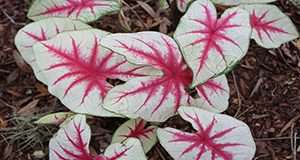 Caladiums are commonly grown in containers, hanging baskets, or planted directly in the landscape as accent and border plants. New caladium cultivar introductions are important to the Florida caladium industry, the greenhouse/nursery industries, and commercial landscape maintenance companies. The UF/IFAS Gulf Coast Research and Education Center released three new caladium cultivars, ‘Cosmic Delight’, ‘Fiesta’, and ‘Hearts Desire’, in 2015. This 7-page document describes the characteristics, production potential, and performance of these cultivars. Written by Zhanao Deng and published by the UF/IFAS Environmental Horticulture Department, December 2017.
Caladiums are commonly grown in containers, hanging baskets, or planted directly in the landscape as accent and border plants. New caladium cultivar introductions are important to the Florida caladium industry, the greenhouse/nursery industries, and commercial landscape maintenance companies. The UF/IFAS Gulf Coast Research and Education Center released three new caladium cultivars, ‘Cosmic Delight’, ‘Fiesta’, and ‘Hearts Desire’, in 2015. This 7-page document describes the characteristics, production potential, and performance of these cultivars. Written by Zhanao Deng and published by the UF/IFAS Environmental Horticulture Department, December 2017.
http://edis.ifas.ufl.edu/ep545
Bloomify Red and Bloomify Rose, Two Infertile Lantana camara Cultivars for Production and Use in Florida
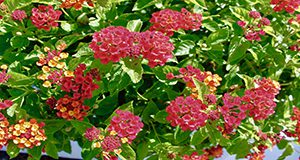 Lantana camara is a popular nursery and landscape plant in the United States; however, it is listed as a Category 1 invasive species to Florida due to its ability to hybridize with Florida’s native plant species Lantana depressa. In 2004, the UF/IFAS Gulf Coast Research and Education Center initiated a research program to develop two highly infertile L. camara cultivars, ‘Bloomify Red’ and ‘Bloomify Rose’. This five-page document discusses the production and characteristics of these cultivars. Written by Zhanao Deng and Sandra B. Wilson and published by the UF/IFAS Environmental Horticulture Department, October 2017. http://edis.ifas.ufl.edu/ep544
Lantana camara is a popular nursery and landscape plant in the United States; however, it is listed as a Category 1 invasive species to Florida due to its ability to hybridize with Florida’s native plant species Lantana depressa. In 2004, the UF/IFAS Gulf Coast Research and Education Center initiated a research program to develop two highly infertile L. camara cultivars, ‘Bloomify Red’ and ‘Bloomify Rose’. This five-page document discusses the production and characteristics of these cultivars. Written by Zhanao Deng and Sandra B. Wilson and published by the UF/IFAS Environmental Horticulture Department, October 2017. http://edis.ifas.ufl.edu/ep544
Sizzle and Passionista: Two New Lance-Leaved Caladium Cultivars
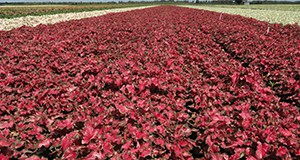 Many lance-leaved cultivars often produce small tubers, making it difficult for growers to produce tubers profitably. ‘Sizzle’ and ‘Passionista’ are two new lance-leaved caladium cultivars with improved tuber yield potential. The availability of ‘Sizzle’ and ‘Passionista’ may expand the color palette for caladium plants desired by greenhouse growers, nurseries, and gardeners. This 7-page fact sheet discusses the cultivars' tuber yield potential, container trials, landscape performance, growing recommendations, and availability. Written by Zhanao Deng, and published by the UF Department of Environmental Horticulture, December 2015.
Many lance-leaved cultivars often produce small tubers, making it difficult for growers to produce tubers profitably. ‘Sizzle’ and ‘Passionista’ are two new lance-leaved caladium cultivars with improved tuber yield potential. The availability of ‘Sizzle’ and ‘Passionista’ may expand the color palette for caladium plants desired by greenhouse growers, nurseries, and gardeners. This 7-page fact sheet discusses the cultivars' tuber yield potential, container trials, landscape performance, growing recommendations, and availability. Written by Zhanao Deng, and published by the UF Department of Environmental Horticulture, December 2015.
http://edis.ifas.ufl.edu/ep527
Alternatives to Invasive Plants Commonly Found in South Florida Landscapes
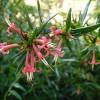 Based on years of UF/IFAS research producing and trialing cultivars, this 5-page fact sheet lists native and non-invasive, non-native ornamentals as alternatives to invasive plants commonly used in Florida landscapes. Only plants considered to be generally available in the nursery trade are listed. Alternative plants are similar to respective invasive plants as much as possible in terms of size, habit, texture, and flower color. Written by Gary W. Knox, Sandra B. Wilson, Zhanao Deng, and Rosanna Freyre, and published by the UF Department of Environmental Horticulture, September 2013.
Based on years of UF/IFAS research producing and trialing cultivars, this 5-page fact sheet lists native and non-invasive, non-native ornamentals as alternatives to invasive plants commonly used in Florida landscapes. Only plants considered to be generally available in the nursery trade are listed. Alternative plants are similar to respective invasive plants as much as possible in terms of size, habit, texture, and flower color. Written by Gary W. Knox, Sandra B. Wilson, Zhanao Deng, and Rosanna Freyre, and published by the UF Department of Environmental Horticulture, September 2013.
http://edis.ifas.ufl.edu/ep483
’Fairytale Princess’ and ’Red Hot’: Red Lance-leaved Caladium Cultivars
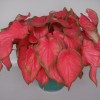 Caladiums are valued in landscapes and containers for their colorful and variable-shaped leaves. Two types of caladium cultivars exist in commercial production: fancy- and lance-leaved. ‘Florida Sweetheart’ is the most popular lance-leaved commercial cultivar of all colors. It produces wide lance leaves with a rosy color and relatively large tubers. ‘Florida Red Ruffles’ is the most popular red, lance-leaved commercial cultivar among caladium growers, greenhouse growers, and nurseries. It has excellent sunburn tolerance. Both cultivars were introduced by the University of Florida (UF) caladium breeding program. This 9-page fact sheet was written by Zhanao Deng, and published by the UF Department of Environmental Horticulture, August 2013.
Caladiums are valued in landscapes and containers for their colorful and variable-shaped leaves. Two types of caladium cultivars exist in commercial production: fancy- and lance-leaved. ‘Florida Sweetheart’ is the most popular lance-leaved commercial cultivar of all colors. It produces wide lance leaves with a rosy color and relatively large tubers. ‘Florida Red Ruffles’ is the most popular red, lance-leaved commercial cultivar among caladium growers, greenhouse growers, and nurseries. It has excellent sunburn tolerance. Both cultivars were introduced by the University of Florida (UF) caladium breeding program. This 9-page fact sheet was written by Zhanao Deng, and published by the UF Department of Environmental Horticulture, August 2013.
http://edis.ifas.ufl.edu/ep481
New Gerbera Daisy Varieties for Large Containers and Flower Gardens
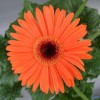 Gerbera daisy is one of the most popular flowers in the United States. Recently, interest has increased in growing gerberas in large containers for indoor or outdoor use. ‘Funtastic™ Tangerine Eye’ and ‘Funtastic™ Golden Eye’ have been selected and tested specifically for use in large containers. These cultivars produce large, powdery mildew-resistant plants and large, attractive flowers in orange-red or yellow-orange that complement the existing Funtastic™ series of gerbera cultivars. This 8-page fact sheet was written by Zhanao Deng, and published by the UF Department of Environmental Horticulture, September 2013.
Gerbera daisy is one of the most popular flowers in the United States. Recently, interest has increased in growing gerberas in large containers for indoor or outdoor use. ‘Funtastic™ Tangerine Eye’ and ‘Funtastic™ Golden Eye’ have been selected and tested specifically for use in large containers. These cultivars produce large, powdery mildew-resistant plants and large, attractive flowers in orange-red or yellow-orange that complement the existing Funtastic™ series of gerbera cultivars. This 8-page fact sheet was written by Zhanao Deng, and published by the UF Department of Environmental Horticulture, September 2013.
http://edis.ifas.ufl.edu/ep482
Alternatives to Invasive Plants Commonly Found in Central Florida Landscapes
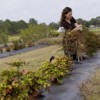 Based on years of UF/IFAS research producing and trialing cultivars, this 3-page fact sheet lists native and non-invasive, non-native ornamentals as alternatives to invasive plants commonly used in Central Florida landscapes. Only plants considered to be generally available in the nursery trade are listed. Alternative plants are similar to respective invasive plants as much as possible in terms of size, habit, texture, and flower color. This 3-page fact sheet was written by Gary W. Knox, Sandra B. Wilson, Zhanao Deng, and Rosanna Freyre, and published by the UF Department of Environmental Horticulture, August 2013.
Based on years of UF/IFAS research producing and trialing cultivars, this 3-page fact sheet lists native and non-invasive, non-native ornamentals as alternatives to invasive plants commonly used in Central Florida landscapes. Only plants considered to be generally available in the nursery trade are listed. Alternative plants are similar to respective invasive plants as much as possible in terms of size, habit, texture, and flower color. This 3-page fact sheet was written by Gary W. Knox, Sandra B. Wilson, Zhanao Deng, and Rosanna Freyre, and published by the UF Department of Environmental Horticulture, August 2013.
http://edis.ifas.ufl.edu/ep468
Alternatives to Invasive Plants Commonly Found in North Florida Landscapes (ENH1206/EP467)
 Based on years of UF/IFAS research producing and trialing cultivars, this 3-page fact sheet lists native and non-invasive, non-native ornamentals as alternatives to invasive plants commonly used in Florida landscapes. Only plants considered to be generally available in the nursery trade are listed. Alternative plants are similar to respective invasive plants as much as possible in terms of size, habit, texture, and flower color.was written by Gary W. Knox, Sandra B. Wilson, Zhanao Deng, and Rosanna Freyre, and published by the UF Department of Environmental Horticulture, August 2013.
Based on years of UF/IFAS research producing and trialing cultivars, this 3-page fact sheet lists native and non-invasive, non-native ornamentals as alternatives to invasive plants commonly used in Florida landscapes. Only plants considered to be generally available in the nursery trade are listed. Alternative plants are similar to respective invasive plants as much as possible in terms of size, habit, texture, and flower color.was written by Gary W. Knox, Sandra B. Wilson, Zhanao Deng, and Rosanna Freyre, and published by the UF Department of Environmental Horticulture, August 2013.
http://edis.ifas.ufl.edu/ep467
UF-T3 and UF-T4: Two Sterile Lantana camara Varieties (ENH1202/EP463)
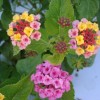 Lantana camara plants are valued for their bright flower color, butterfly attraction, tolerance to harsh environmental conditions, low maintenance requirements, and ease of propagation and production. But many existing varieties can be weedy or invasive when grown in tropical and subtropical regions. So in 2004, UF/IFAS started a program to develop sterile L. camara varieties with little to no invasive potential.
Lantana camara plants are valued for their bright flower color, butterfly attraction, tolerance to harsh environmental conditions, low maintenance requirements, and ease of propagation and production. But many existing varieties can be weedy or invasive when grown in tropical and subtropical regions. So in 2004, UF/IFAS started a program to develop sterile L. camara varieties with little to no invasive potential.
This 8-page fact sheet introduces the recently released UF-T3 and UF-T4 lantana varieties that have resulted from these breeding, selection, and testing efforts. Written by Zhanao Deng, David M. Czarnecki II, Sandra B. Wilson, Gary W. Knox, and Rosanna Freyre, and published by the UF Department of Environmental Horticulture, August 2012.
http://edis.ifas.ufl.edu/ep463
'Strawberry Star': A Spotted, Fancy-Leaved Caladium for Use in Containers and Landscapes (ENH1201/EP462)
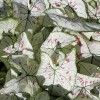 'Strawberry Star' is a fancy-leaved variety with a primarily white leaf face and attractive red spots. It is similar to 'Marie Moir' in leaf color and coloration pattern but different from 'Marie Moir' in petiole color. Compared to 'Marie Moir', 'Strawberry Star' sprouts earlier, produces high-quality container plants, demonstrates better landscape performance, and yields more tubers. These improvements make 'Strawberry Star' a desirable replacement for 'Marie Moir' and an additional sun-tolerant variety for the landscape plant palette. This 5-page fact sheet was written by Zhanao Deng, and published by the UF Department of Environmental Horticulture, August 2012.
'Strawberry Star' is a fancy-leaved variety with a primarily white leaf face and attractive red spots. It is similar to 'Marie Moir' in leaf color and coloration pattern but different from 'Marie Moir' in petiole color. Compared to 'Marie Moir', 'Strawberry Star' sprouts earlier, produces high-quality container plants, demonstrates better landscape performance, and yields more tubers. These improvements make 'Strawberry Star' a desirable replacement for 'Marie Moir' and an additional sun-tolerant variety for the landscape plant palette. This 5-page fact sheet was written by Zhanao Deng, and published by the UF Department of Environmental Horticulture, August 2012.
http://edis.ifas.ufl.edu/ep462
'Summer Pink': A New Pink, Fancy-Leaved Caladium Variety (ENH1200/EP461)
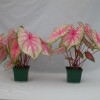 ‘Summer Pink’ is a new fancy-leaved caladium variety developed by the University of Florida’s Institute of Food and Agricultural Sciences (UF/IFAS) caladium breeding program for use in large containers and shady locations in the landscape (Deng and Harbaugh 2012). Leaves of this variety have a pink face and pink veins. In replicated field and greenhouse trials, ‘Summer Pink’ performed comparably or better than ‘Fannie Munson’ and ‘White Queen’, two pink caladium varieties commonly used in containers and landscapes. This 4-page fact sheet was written by Zhanao Deng, and published by the UF Department of Environmental Horticulture, August 2012.
‘Summer Pink’ is a new fancy-leaved caladium variety developed by the University of Florida’s Institute of Food and Agricultural Sciences (UF/IFAS) caladium breeding program for use in large containers and shady locations in the landscape (Deng and Harbaugh 2012). Leaves of this variety have a pink face and pink veins. In replicated field and greenhouse trials, ‘Summer Pink’ performed comparably or better than ‘Fannie Munson’ and ‘White Queen’, two pink caladium varieties commonly used in containers and landscapes. This 4-page fact sheet was written by Zhanao Deng, and published by the UF Department of Environmental Horticulture, August 2012.
http://edis.ifas.ufl.edu/ep461
‘Cherry Tart’: A Dwarf Red Lance-Leaved Caladium Variety (ENH1184/EP445)
 This 5-page fact sheet introduces a new lance-leafed caladium variety that was released in April 2011. It has bright red color, slightly undulate leaf margins, and a broadly cordate leaf shape. Written by Zhanao Deng and published by the UF Department of Environmental Horticulture, August 2011.
This 5-page fact sheet introduces a new lance-leafed caladium variety that was released in April 2011. It has bright red color, slightly undulate leaf margins, and a broadly cordate leaf shape. Written by Zhanao Deng and published by the UF Department of Environmental Horticulture, August 2011.
http://edis.ifas.ufl.edu/ep445
‘Tapestry’: A Pink Fancy-Leaved Caladium Variety for Containers and Landscapes (ENH1183/EP444)
 Move over ‘Carolyn Whorton’, there’s a new variety of fancy-leaved pink caladium coming on the scene. ‘Tapestry’ is intended for use in large containers and landscapes. This 5-page fact sheet was written by Zhanao Deng, and published by the UF Department of Environmental Horticulture, August 2011.
Move over ‘Carolyn Whorton’, there’s a new variety of fancy-leaved pink caladium coming on the scene. ‘Tapestry’ is intended for use in large containers and landscapes. This 5-page fact sheet was written by Zhanao Deng, and published by the UF Department of Environmental Horticulture, August 2011.
http://edis.ifas.ufl.edu/ep444
ENH1170/EP431 New Gerbera Daisy Varieties for Large Containers and Flower Gardens
ENH1170, a 6-page illustrated fact sheet by Zhanao Deng, describes six new varieties of this popular brightly colored flower that have been released recently by the UF/IFAS gerbera breeding program — descriptions, powdery mildew resistance, availability, greenhouse production and plant care in large containers or flower gardens. Includes references. Published by the UF Department of Environmental Horticulture, July 2010.
http://edis.ifas.ufl.edu/ep431
ENH1139/EP400 ‘Berry Patch’ – A New University of Florida Caladium Variety for Use in Sunny Landscapes and Containers
ENH1139, a 6-page illustrated fact sheet by Zhanao Deng and Brent K. Harbaugh, describes this new, spotted, fancy-leaved caladium variety with superior tuber yields — origin, description, tuber production, landscape performance, container forcing, and availability. Includes references. Published by the UF Department of Environmental Horticulture, October 2009.
http://edis.ifas.ufl.edu/EP400
ENH1109/EP372 ‘UF-331’ and ‘UF-340’ – Two University of Florida Dwarf Caladium Varieties for Containers and Landscapes
ENH-1109, a 7-page illustrated fact sheet by Zhanao Deng, describes these two new lance-leafed caladium varieties with novel combinations of foliar characteristics — their origin, description, tuber production, container forcing and performance, landscape performance, recommendations and availability. Includes references. Published by the UF Department of Environmental Horticulture, January 2009.
http://edis.ifas.ufl.edu/EP372
